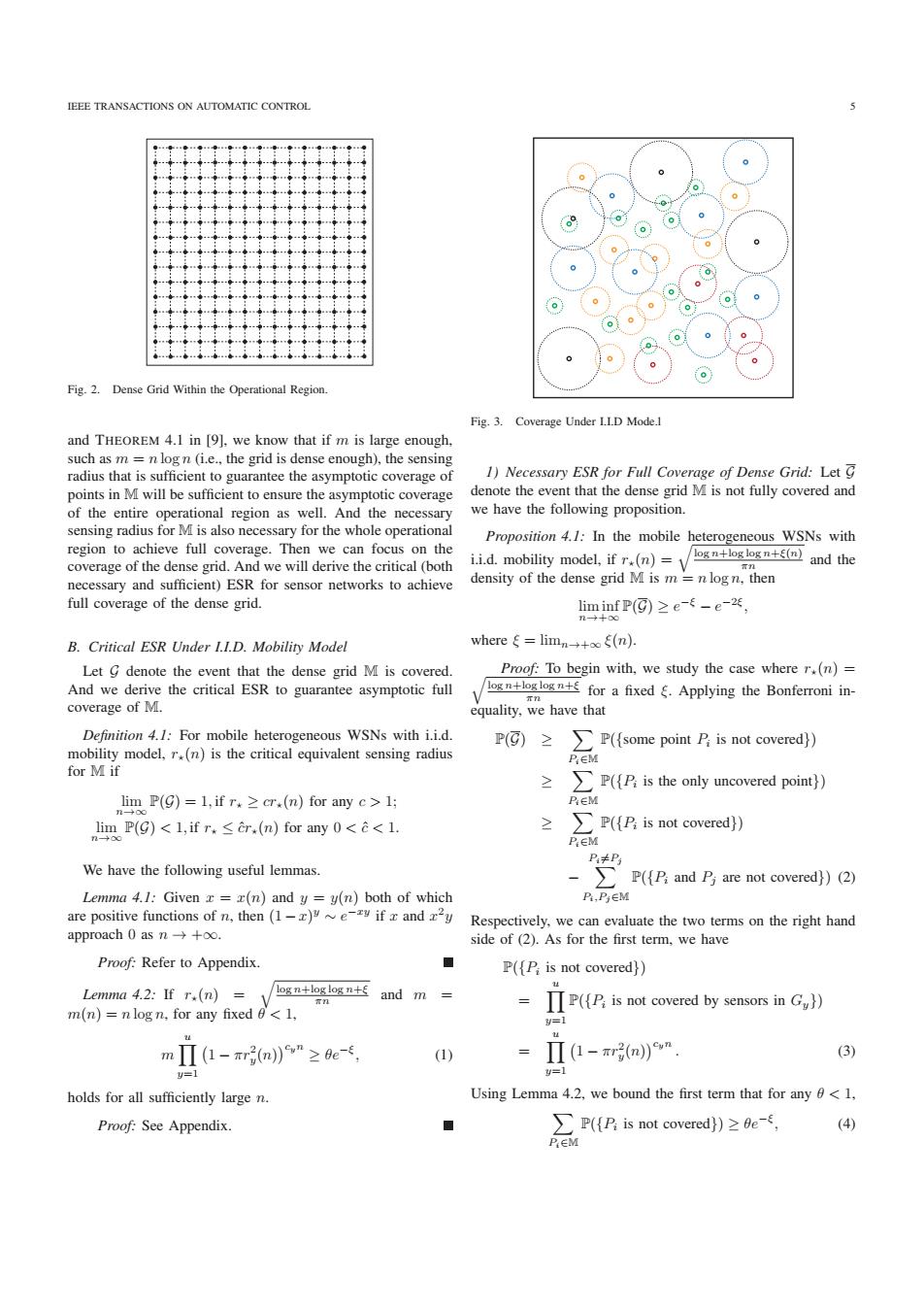正在加载图片...

IEEE TRANSACTIONS ON AUTOMATIC CONTROL ● Fig.2.Dense Grid Within the Operational Region Fig.3.Coverage Under L.I.D Mode.1 and THEOREM 4.1 in [9],we know that if m is large enough, such as m =n log n(i.e.,the grid is dense enough),the sensing radius that is sufficient to guarantee the asymptotic coverage of 1)Necessary ESR for Full Coverage of Dense Grid:Let g points in M will be sufficient to ensure the asymptotic coverage denote the event that the dense grid M is not fully covered and of the entire operational region as well.And the necessary we have the following proposition sensing radius for M is also necessary for the whole operational Proposition 4.1:In the mobile heterogeneous WSNs with region to achieve full coverage.Then we can focus on the coverage of the dense grid.And we will derive the critical (both i.i.d.mobility model,ifr(n)-)and the necessary and sufficient)ESR for sensor networks to achieve density of the dense grid M is m =n log n,then full coverage of the dense grid. liminfP(©)≥e-f-e-2s, n- B.Critical ESR Under I.I.D.Mobility Model whereξ=limn→+o(n). Let G denote the event that the dense grid M is covered. Proof:To begin with,we study the case where r.(n)= And we derive the critical ESR to guarantee asymptotic full logn+loglogn+for a fixed Applying the Bonferroni in- n coverage of M. equality,we have that Definition 4.1:For mobile heterogeneous WSNs with i.i.d. P(g)≥ P({some point P is not covered}) mobility model,r.(n)is the critical equivalent sensing radius PEM for M if P(is the only uncovered point}) lim P(9)=1,if r.cr.(n)for any c>1; PEM lim P(g)<1,if r.<er,(n)for any 0<<1. P(P:is not covered}) PEM We have the following useful lemmas. P≠P -P({P:and Pj are not covered})(2) Lemma 4.1:Given x =x(n)and y=y(n)both of which P,P∈M are positive functions of n,then (1-x)~e-zy if x and z2y Respectively,we can evaluate the two terms on the right hand approach0asn→+oo. side of (2).As for the first term,we have Proof:Refer to Appendix. P([P:is not covered}) Lemma 4.2:If r.(n) logn+log log n+≤ 1 and m 4 m(n)=nlog n,for any fixed <1, P(P is not covered by sensors in G) y=1 mΠ(1-r(n)"≥e- (1) (1-n)" (3) y=1 y=1 holds for all sufficiently large n. Using Lemma 4.2,we bound the first term that for any <1, Proof:See Appendix. >P({P:is not covered})>0e-, (4) P.EMIEEE TRANSACTIONS ON AUTOMATIC CONTROL 5 Fig. 2. Dense Grid Within the Operational Region. and THEOREM 4.1 in [9], we know that if m is large enough, such as m = n log n (i.e., the grid is dense enough), the sensing radius that is sufficient to guarantee the asymptotic coverage of points in M will be sufficient to ensure the asymptotic coverage of the entire operational region as well. And the necessary sensing radius for M is also necessary for the whole operational region to achieve full coverage. Then we can focus on the coverage of the dense grid. And we will derive the critical (both necessary and sufficient) ESR for sensor networks to achieve full coverage of the dense grid. B. Critical ESR Under I.I.D. Mobility Model Let G denote the event that the dense grid M is covered. And we derive the critical ESR to guarantee asymptotic full coverage of M. Definition 4.1: For mobile heterogeneous WSNs with i.i.d. mobility model, r(n) is the critical equivalent sensing radius for M if limn→∞ P(G)=1, if r ≥ cr(n) for any c > 1; limn→∞ P(G) < 1, if r ≤ crˆ (n) for any 0 < c <ˆ 1. We have the following useful lemmas. Lemma 4.1: Given x = x(n) and y = y(n) both of which are positive functions of n, then (1 − x)y ∼ e−xy if x and x2y approach 0 as n → +∞. Proof: Refer to Appendix. Lemma 4.2: If r(n) = log n+log log n+ξ πn and m = m(n) = n log n, for any fixed θ < 1, m u y=1 1 − πr2 y(n) cyn ≥ θe−ξ, (1) holds for all sufficiently large n. Proof: See Appendix. Fig. 3. Coverage Under I.I.D Mode.l 1) Necessary ESR for Full Coverage of Dense Grid: Let G denote the event that the dense grid M is not fully covered and we have the following proposition. Proposition 4.1: In the mobile heterogeneous WSNs with i.i.d. mobility model, if r(n) = log n+log log n+ξ(n) πn and the density of the dense grid M is m = n log n, then lim inf n→+∞ P(G) ≥ e−ξ − e−2ξ, where ξ = limn→+∞ ξ(n). Proof: To begin with, we study the case where r(n) = log n+log log n+ξ πn for a fixed ξ. Applying the Bonferroni inequality, we have that P(G) ≥ Pi∈M P({some point Pi is not covered}) ≥ Pi∈M P({Pi is the only uncovered point}) ≥ Pi∈M P({Pi is not covered}) − P i=Pj Pi,Pj∈M P({Pi and Pj are not covered}) (2) Respectively, we can evaluate the two terms on the right hand side of (2). As for the first term, we have P({Pi is not covered}) = u y=1 P({Pi is not covered by sensors in Gy}) = u y=1 1 − πr2 y(n) cyn . (3) Using Lemma 4.2, we bound the first term that for any θ < 1, Pi∈M P({Pi is not covered}) ≥ θe−ξ, (4)��������